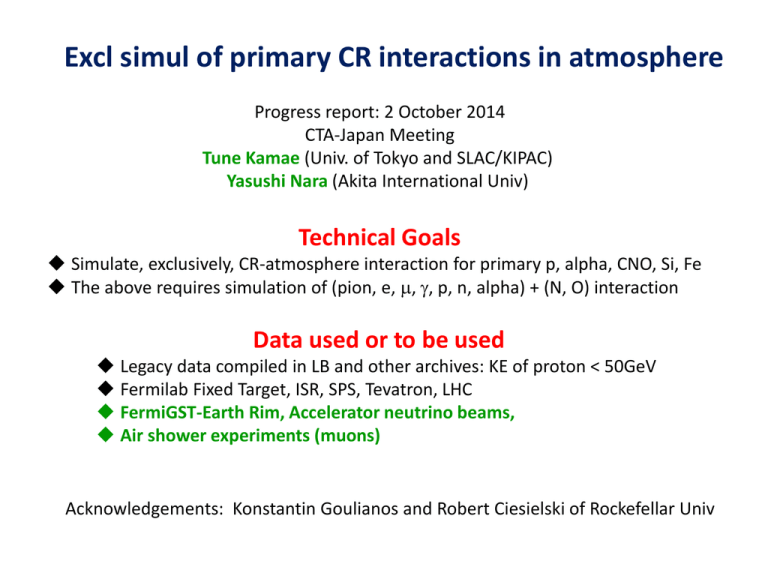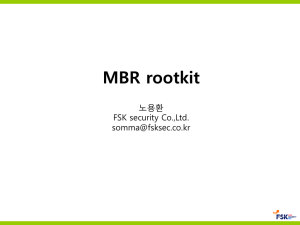g Production in CR ISM Interaction
advertisement

Excl simul of primary CR interactions in atmosphere Progress report: 2 October 2014 CTA-Japan Meeting Tune Kamae (Univ. of Tokyo and SLAC/KIPAC) Yasushi Nara (Akita International Univ) Technical Goals Simulate, exclusively, CR-atmosphere interaction for primary p, alpha, CNO, Si, Fe The above requires simulation of (pion, e, m, g, p, n, alpha) + (N, O) interaction Data used or to be used Legacy data compiled in LB and other archives: KE of proton < 50GeV Fermilab Fixed Target, ISR, SPS, Tevatron, LHC FermiGST-Earth Rim, Accelerator neutrino beams, Air shower experiments (muons) Acknowledgements: Konstantin Goulianos and Robert Ciesielski of Rockefellar Univ JAM and Pythia8 MBR Below KE < 100GeV: Resonance productions based on Quantum Molecular Dynamics (QMD) models (RQMD and UrQMD variants) Nuclear part is simulated in a sequence of collisions with “shadowing” effects KE > 50-100GeV: Choice 1: HIJING model (perturbative QCD extended to pA and AA) has been tried but abandoned because the codes are not maintained anymore. Also the model is known to violate, often, the energy-momentum conservation. • X. N. Wang and M. Gyulassy; Phys. Rev. D44 (1991) 3501 • X. N. Wang; Physics Report 280 (1997) 287 Choice 2: Pythia 8 Minimum Bias Rockefeller reproduces the minimum-bias events in a widest energy range from Ecm=10GeV to LHC energies. However it has been developed only for single particle collisions and need to be extended to include light-to-medium nuclei. • Pythia: T. Sjostrand; Comp. Phys. Comm. 82 (1994) 74 • Pythia 8: T. Sjostrand; Pythia8.1 Tutorial (Nov-Dec 2007) • R. Ciesielski and K. Goulianos; arXiv 1205.1446 (Aug 2012) “MBR Monte Carlo Simulation” • Pythia 8 MBR: R. Ciesielski; Revent developments on diffraction in Pythia8 (Dec 2012 CERN) pp >Inelastic: Resonance region OBE Resonance Excitation Models pp>NN2p by Teis et al Baryon Resonance Excitation: pp (JAM) KE=0.4GeV sld: proj Dsh: tgt D(1232) KE=5.0GeV sld: proj Dsh: tgt D(1232) N* res N(1440) KE=20GeV sld: proj D(1232) Dsh: tgt Higher D KE=1TeV sld: proj Dsh: tgt D(1232) N* res Higher D N* res Higher D Baryon res & Nav(p,K,h) : JAM pp pp> pion multiplicity: JAM pp > pions: Exp data vs. JAM Data and JAM pp > Charged Multiplicity (JAM) KE=100GeV KE=1TeV pp> N charged prong: Exp dat vs JAM JAM pHe > pions (JAM) pHe > Charged Multiplicity (JAM) KE=100GeV KE=1TeV pHe > N charge prongs (JAM) No major issues but many minor issues Eta prod higher in pn near thres Teis et al; Z. Physik 1997 Klaja et al; arXiv:1003.4378 (2010) More h in pn: some other mechanism? Pythia8 Mini Bias Rockefellar CMS data and Pythia8MBR CMS SD2 sample reproduced well by Pythia8MBR SD2 all Remove non-diff Tag double-diff Pythia8 MBR tot cross-sec: p/p-bar, pi+/Pi-,K+/K- Pythia8 MBR vs LHC Pythia MBR vs Pythia8 4C (default) Pythia MBR vs Pythia8 4C (default) Merit of Pythia8 MBR Pythia8 MBR reproduces experimental data better at LHC energies and reproduces experimental data at Tevatron Pythia8 MBR vs other simulators (CMS data) Note: Most simulators are not firmaly based on QCD and include several arbitrary parameters. Current Status of Pythia8 MBR Sim 31% of events includes g come from non-pi0 at KE=1TeV Nearly 40% of events are diff events and their charged multiplicity is low. Current Status of Pythia8 MBR Sim Energetic g’s are from single diff and accompany few or no pi+/pi- Current Status of Pythia8 MBR Sim Energetic g’s are from single diff and may no accompany pi+/pi- Combining JAM and Pythia8MBR Pythia8MBR predicts 3-4mb for 2 prong evnts. Work to be done Extension of Pythia8 MBR to (pion, e, m, g, p, n, alpha) + (N, O) Test against FermiGST-Earth Rim g-rays Angular distribution Rigidity cut-off dependence Test against accelerator neutrino beams (pAl) This work will open up a new venue to study primary CR Neutrino detectors (muon bundles) CTA including background studies Air shower arrays (HAWC, Tibet, TA, Auger)






